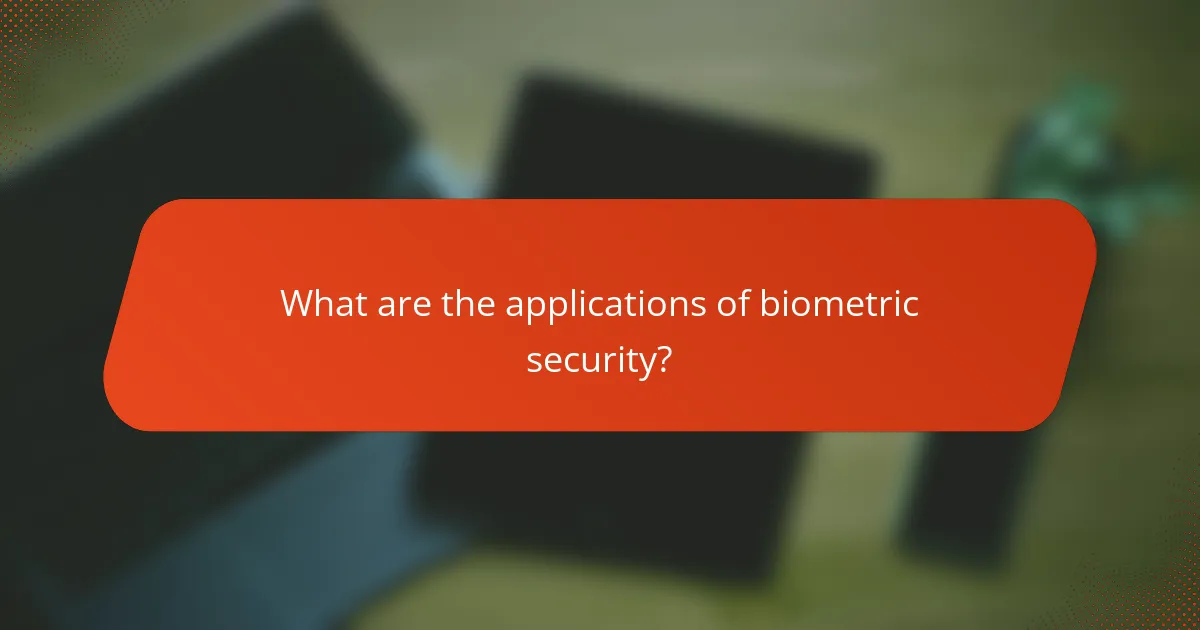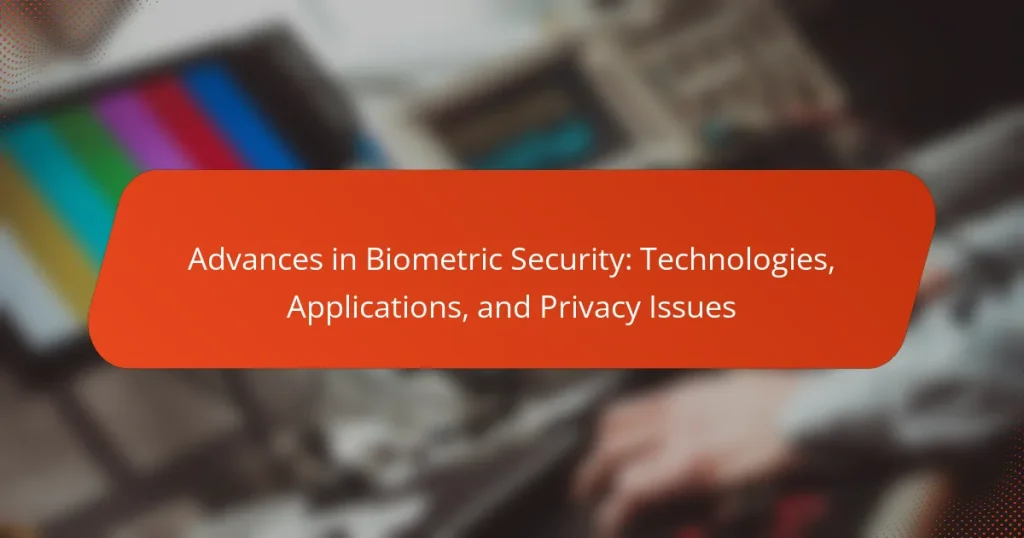Advances in biometric security encompass the latest technological developments that enhance the accuracy and reliability of biometric identification systems, including fingerprint recognition, facial recognition, and iris scanning. Key innovations involve improved algorithms, deep learning techniques, and multimodal biometric systems that integrate various biometric traits for heightened security. These advancements are applied across sectors such as banking, healthcare, and law enforcement for user authentication and identity verification. However, the use of biometric data raises significant privacy concerns, including unauthorized access, data breaches, and the potential for continuous surveillance, emphasizing the need for stringent regulations and security measures.

What are Advances in Biometric Security?
Advances in biometric security refer to the latest developments in technology that enhance the accuracy and reliability of biometric identification systems. These advancements include improved algorithms for fingerprint recognition, [censured] recognition, and iris scanning. For instance, deep learning techniques have significantly increased the accuracy of [censured] recognition systems, achieving error rates below 1%. Additionally, multimodal biometric systems combine different biometric traits for enhanced security. The integration of artificial intelligence in biometric systems allows for real-time processing and adaptive learning. Research by the National Institute of Standards and Technology (NIST) indicates that these technologies are becoming faster and more efficient. Furthermore, advances in hardware, such as high-resolution cameras and sensors, support these improved biometric systems. These innovations are being applied in various sectors, including banking, healthcare, and law enforcement, to enhance security measures and user authentication.
How do biometric security systems function?
Biometric security systems function by identifying individuals based on unique biological traits. These traits can include fingerprints, [censured] recognition, iris patterns, or voice recognition. The system captures the biometric data through sensors. This data is then converted into a digital format for analysis. The system compares the captured data against stored templates in a database. If there is a match, access is granted. If not, access is denied. Studies show that biometric systems can achieve accuracy rates exceeding 99%. This high accuracy makes them a reliable security option.
What types of biometric identification methods are commonly used?
Commonly used biometric identification methods include fingerprint recognition, [censured] recognition, iris scanning, and voice recognition. Fingerprint recognition analyzes unique patterns on a person’s fingertips. This method is widely used due to its accuracy and ease of implementation. [censured] recognition uses algorithms to identify [censured] features and is increasingly utilized in security systems. Iris scanning captures the unique patterns in the colored part of the eye, providing a high level of accuracy. Voice recognition analyzes vocal characteristics and is often used for authentication in phone systems. These methods leverage unique human traits for secure identification.
What technologies underpin biometric security systems?
Biometric security systems are underpinned by several key technologies. These include fingerprint recognition, [censured] recognition, iris scanning, and voice recognition. Fingerprint recognition uses unique patterns on an individual’s fingertips for identification. [censured] recognition analyzes [censured] features and compares them to stored images. Iris scanning captures the unique patterns in the colored part of the eye. Voice recognition relies on vocal characteristics for authentication. Each technology utilizes algorithms to analyze and match biometric data. These systems enhance security by providing unique identification methods. They are widely used in various applications, including mobile devices and secure access control.
What are the key benefits of biometric security?
Biometric security offers several key benefits. First, it provides enhanced security through unique identification methods. Biometric traits, such as fingerprints and [censured] recognition, are difficult to replicate. This makes unauthorized access more challenging. Second, biometric systems streamline user authentication. Users do not need to remember passwords or carry access cards. Third, biometric security improves user convenience. Authentication is often faster and more user-friendly. Fourth, it reduces the risk of identity theft. Biometric data is inherently linked to the individual, making fraud harder. These benefits contribute to increased trust in security systems.
How does biometric security enhance user convenience?
Biometric security enhances user convenience by allowing quick and easy access through unique physical traits. Users can unlock devices or authenticate without remembering passwords. This method reduces time spent on authentication processes. According to a study by the National Institute of Standards and Technology, biometric systems can improve user experience by decreasing login times by up to 90%. Additionally, biometric data is often more secure than traditional passwords, minimizing the risk of unauthorized access. This combination of speed and security leads to a smoother user experience overall.
What advantages does biometric security offer over traditional methods?
Biometric security offers enhanced accuracy and reliability compared to traditional methods. Traditional methods often rely on passwords or PINs, which can be easily forgotten or stolen. In contrast, biometric systems use unique physical traits, such as fingerprints or [censured] recognition, making them difficult to replicate.
According to a study by the National Institute of Standards and Technology, biometric systems can achieve accuracy rates exceeding 99%. This high level of precision reduces the risk of unauthorized access. Biometric data is inherently tied to individuals, providing a stronger link to identity than traditional methods.
Furthermore, biometric systems can streamline user experience by eliminating the need for remembering passwords. This convenience encourages better security practices among users. Overall, biometric security presents significant advantages in terms of accuracy, user experience, and identity verification.
What are the current trends in biometric security technology?
Current trends in biometric security technology include the increasing adoption of multi-factor authentication systems. These systems combine biometric data with other security methods for enhanced protection. Another trend is the advancement of [censured] recognition technology, which is being integrated into smartphones and security systems. Moreover, the use of biometric data in payment systems is on the rise, allowing for faster and more secure transactions. Additionally, there is a growing emphasis on privacy and data protection regulations surrounding biometric data usage. Companies are developing solutions that prioritize user consent and data encryption. Finally, machine learning algorithms are improving the accuracy of biometric recognition, reducing false positives and negatives. These trends highlight the evolving landscape of biometric security technology.
How is artificial intelligence impacting biometric security?
Artificial intelligence is significantly enhancing biometric security systems. AI algorithms improve the accuracy of [censured] recognition, fingerprint analysis, and iris scanning. These advancements reduce false positives and negatives, leading to more reliable identification. For example, AI can analyze biometric data patterns at a faster rate than traditional methods. This efficiency allows for real-time authentication in various applications. Additionally, AI helps in detecting and preventing spoofing attacks, such as using photos or masks to deceive [censured] recognition systems. According to a report by MarketsandMarkets, the global AI in the biometrics market is expected to reach $16.5 billion by 2025, indicating growing investment and trust in these technologies.
What role does machine learning play in biometric authentication?
Machine learning enhances biometric authentication by improving accuracy and efficiency. It analyzes complex data patterns in biometric traits such as fingerprints, [censured] features, and iris scans. Machine learning algorithms can adapt to new data, reducing false acceptance and rejection rates. For example, deep learning techniques are used to process images for [censured] recognition, achieving over 99% accuracy in some systems. These algorithms learn from large datasets, enabling them to recognize subtle variations in biometric inputs. This adaptability makes biometric systems more robust against spoofing attacks. Overall, machine learning significantly strengthens the reliability of biometric authentication methods.

What are the applications of biometric security?
Biometric security has various applications across multiple sectors. It is widely used in mobile device security. Fingerprint recognition allows users to unlock phones and access sensitive information. [censured] recognition technology is employed for secure access in smartphones and laptops. Biometric systems are also utilized in banking for identity verification during transactions. Access control systems in corporate environments often use iris recognition or fingerprint scanning. Government agencies implement biometric security for border control and national identification systems. Healthcare facilities use biometric identification to ensure patient safety and secure access to medical records. Additionally, biometric security is increasingly applied in law enforcement for criminal identification through fingerprint and [censured] recognition databases.
In which sectors is biometric security most effectively implemented?
Biometric security is most effectively implemented in sectors such as finance, healthcare, and government. In the finance sector, biometric authentication enhances security for online banking and transactions. Many banks utilize fingerprint and [censured] recognition to prevent fraud. In healthcare, biometric security protects patient data and ensures secure access to medical records. Hospitals often use biometric systems for staff identification and patient verification. Government agencies implement biometric security for national identification and border control. Systems like fingerprint scanners and iris recognition aid in maintaining national security. Additionally, the travel sector employs biometric technology for passport control and boarding processes. These implementations showcase the versatility and effectiveness of biometric security across various industries.
How is biometric security utilized in financial services?
Biometric security is utilized in financial services to enhance authentication and fraud prevention. Financial institutions implement fingerprint scanning, [censured] recognition, and iris scanning for secure access to accounts. These methods provide a unique identifier that is difficult to replicate. For instance, banks use fingerprint recognition for mobile banking apps, ensuring only authorized users can access sensitive information. According to a report by Juniper Research, biometric authentication can reduce fraud by up to 90%. Additionally, biometric data is often stored securely, minimizing the risk of data breaches. This technology not only improves security but also streamlines user experience in transactions.
What applications exist in healthcare for biometric security?
Biometric security applications in healthcare include patient identification, access control, and data protection. Patient identification uses fingerprints or iris scans to confirm identities. This reduces errors in medication administration and treatment. Access control restricts entry to sensitive areas using biometric verification. It enhances security for medical records and pharmaceutical storage. Data protection employs biometric encryption methods to secure patient information. These applications improve compliance with regulations like HIPAA. They also enhance patient trust in healthcare systems. Studies show that biometric systems can reduce fraud and improve operational efficiency.
What are some innovative uses of biometric technology?
Innovative uses of biometric technology include secure access control, identity verification, and health monitoring. Secure access control utilizes fingerprint or [censured] recognition systems to grant entry to buildings and devices. Identity verification is employed in online banking and travel, enhancing security and user convenience. Health monitoring applications track physiological metrics through biometric sensors, providing real-time health insights. Biometric technology is also used in law enforcement for criminal identification through [censured] recognition databases. Additionally, it aids in personalizing user experiences in retail through behavioral biometrics. These applications demonstrate the versatility and growing importance of biometric technology in various sectors.
How is biometric security being integrated into smart devices?
Biometric security is being integrated into smart devices through various technologies such as fingerprint sensors, [censured] recognition, and iris scanning. These methods enhance device security by providing unique user identification. Fingerprint sensors are commonly embedded in smartphones and tablets, allowing quick access. [censured] recognition technology is increasingly used in devices like laptops and smart home systems for secure authentication. Iris scanning is also emerging in high-end devices for added security. The integration of these biometric systems helps mitigate unauthorized access and enhances user convenience. According to a report by MarketsandMarkets, the biometric market is expected to grow significantly, reflecting increased adoption in consumer electronics.
What role does biometric security play in access control systems?
Biometric security plays a crucial role in access control systems by providing a reliable method of authentication. It utilizes unique biological traits, such as fingerprints, [censured] recognition, or iris scans, to verify an individual’s identity. This technology enhances security by ensuring that only authorized users gain access to restricted areas or information.
According to a report by MarketsandMarkets, the biometric market is projected to grow significantly, reflecting its increasing adoption in access control systems. Biometric systems reduce the risk of unauthorized access compared to traditional methods like passwords or keycards. A study published in the Journal of Information Security found that biometric authentication has a lower false acceptance rate, enhancing overall security.
Additionally, biometric data is difficult to replicate or steal, making it a robust solution for safeguarding sensitive information. The integration of biometric security in access control systems streamlines the authentication process, improving user convenience while maintaining high security standards.

What privacy issues are associated with biometric security?
Biometric security raises significant privacy issues, primarily concerning data collection and storage. The collection of biometric data, such as fingerprints or [censured] recognition, can lead to unauthorized access and misuse. Once collected, biometric data is often stored in databases that can be vulnerable to breaches. A breach can expose sensitive personal information, leading to identity theft. Additionally, biometric data is immutable; unlike passwords, it cannot be changed if compromised. There are also concerns over surveillance and tracking, as biometric systems can enable continuous monitoring of individuals. These privacy issues highlight the need for stringent regulations and security measures in biometric systems.
What are the primary concerns regarding biometric data privacy?
The primary concerns regarding biometric data privacy include unauthorized access, data breaches, and misuse of information. Biometric data is unique to individuals, making it highly sensitive. If compromised, it cannot be changed like passwords. Unauthorized access can lead to identity theft or fraud. Data breaches have become more common, exposing personal information. Misuse of biometric data can occur in surveillance or tracking without consent. According to a 2020 report by the Electronic Frontier Foundation, biometric data lacks strong legal protections. Many users are unaware of how their data is collected and used. These factors contribute to growing public concern over biometric data privacy.
How is biometric data collected and stored?
Biometric data is collected through various methods, including fingerprint scanning, [censured] recognition, and iris scanning. These methods utilize specialized sensors to capture unique biological traits. For instance, fingerprint scanners use capacitive or optical sensors to read the ridges and valleys of a fingerprint. [censured] recognition systems analyze key [censured] features and distances between them. Iris scanners capture detailed images of the iris patterns.
Once collected, biometric data is typically stored in encrypted databases. This ensures that sensitive information is protected from unauthorized access. Data storage solutions can be on-premises or in the cloud, depending on the organization’s infrastructure. Encrypted formats are essential to maintain privacy and security.
According to a report by the National Institute of Standards and Technology, secure storage practices are crucial for preventing data breaches. Regular audits and updates to security protocols further enhance the protection of biometric data.
What risks are involved in the misuse of biometric information?
The misuse of biometric information poses significant risks, including identity theft, unauthorized access, and privacy violations. Identity theft occurs when biometric data, such as fingerprints or [censured] recognition, is stolen and used to impersonate individuals. Unauthorized access can happen when biometric systems are hacked, allowing attackers to gain entry to secure locations or systems. Privacy violations arise when biometric data is collected and used without consent, leading to surveillance and tracking of individuals. According to a study by the National Institute of Standards and Technology (NIST), 1 in 5 biometric systems can be compromised, highlighting the vulnerability of these technologies. Additionally, once biometric data is compromised, it cannot be changed like a password, making the consequences long-lasting.
How can individuals protect their biometric data?
Individuals can protect their biometric data by using strong encryption and secure storage methods. Encryption ensures that biometric information is converted into a secure format. Secure storage prevents unauthorized access to the data. Individuals should also limit the sharing of their biometric data. Only share it with trusted services and applications. Regularly update passwords and security settings for accounts that use biometric data. Be cautious of phishing attempts that may seek biometric information. Monitoring accounts for unusual activity can help detect potential breaches. These practices collectively enhance the security of biometric data against unauthorized use.
What best practices should users follow to safeguard their biometric information?
Users should follow several best practices to safeguard their biometric information. First, they should enable two-factor authentication when available. This adds an extra layer of security beyond just biometrics. Second, users must avoid sharing biometric data with untrusted applications or devices. Research shows that unauthorized access can lead to identity theft. Third, users should regularly update their devices and software. This helps protect against vulnerabilities that could be exploited. Fourth, users must be cautious about where they store biometric data. Secure storage solutions are essential to prevent unauthorized access. Finally, users should monitor their accounts for unusual activity. Early detection can mitigate the impact of potential breaches.
What regulatory measures exist to protect biometric data privacy?
Regulatory measures to protect biometric data privacy include various laws and frameworks. The General Data Protection Regulation (GDPR) in the European Union sets strict guidelines for the processing of personal data, including biometric information. Under GDPR, biometric data is classified as sensitive personal data. This classification requires explicit consent from individuals before their data can be processed.
In the United States, several states have enacted laws, such as the Illinois Biometric Information Privacy Act (BIPA). BIPA mandates that companies obtain informed consent before collecting biometric data. It also requires organizations to implement reasonable safeguards to protect this data.
Additionally, the California Consumer Privacy Act (CCPA) includes provisions that affect biometric data. The CCPA grants consumers the right to know what personal information is collected and provides options for opting out.
These regulations aim to enhance transparency and accountability in the handling of biometric data. They also empower individuals with rights concerning their personal information.
What future developments can we expect in biometric security?
Future developments in biometric security will include enhanced accuracy and speed of recognition systems. Advances in artificial intelligence will improve the algorithms used for biometric data analysis. Multi-modal biometric systems will combine various biometric traits for better security. For instance, combining [censured] recognition with fingerprint scanning can reduce false positives. Privacy-preserving techniques will emerge to protect biometric data from unauthorized access. Blockchain technology may be utilized for secure storage of biometric information. Additionally, biometric authentication will become more integrated into everyday devices like smartphones and wearables. These developments are driven by the increasing demand for secure and user-friendly authentication methods.
How might emerging technologies shape the future of biometric security?
Emerging technologies will significantly enhance biometric security through improved accuracy and user convenience. Advanced machine learning algorithms can analyze biometric data more effectively. This leads to higher recognition rates and reduced false positives. Additionally, decentralized storage solutions, like blockchain, can secure biometric data against breaches. Quantum computing may also improve encryption methods used in biometric systems. Moreover, the integration of artificial intelligence can enable real-time threat detection. These advancements will make biometric systems more reliable and user-friendly. As a result, biometric security will become a preferred method for authentication in various sectors.
What trends should users watch for in biometric security advancements?
Users should watch for several key trends in biometric security advancements. Increased integration of artificial intelligence is enhancing biometric accuracy and efficiency. Multi-factor biometrics are becoming more common, combining different biometric modalities for improved security. Privacy concerns are driving the development of privacy-preserving biometric systems. Contactless biometric technologies are gaining traction due to hygiene and convenience preferences. Advances in liveness detection are improving resistance against spoofing attacks. Furthermore, regulatory frameworks are evolving to address biometric data protection. These trends reflect a shift towards more secure, user-friendly, and privacy-conscious biometric solutions.
Advances in biometric security encompass the latest technological developments aimed at enhancing the accuracy and reliability of biometric identification systems, including fingerprint recognition, [censured] recognition, and iris scanning. The article explores how these systems function, their common methods, and underlying technologies, highlighting key benefits such as improved security, user convenience, and reduced identity theft risks. Additionally, it addresses current trends, applications across various sectors like finance and healthcare, and the privacy issues associated with biometric data collection and storage. Regulatory measures and future developments in this field are also discussed, emphasizing the impact of artificial intelligence and emerging technologies on biometric security systems.




